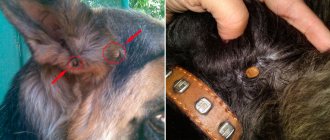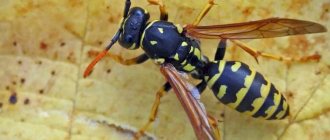- Ixodid ticks
- Ear mites
- Argasid mites
- Heyletiella
- Hair mites – demodexes
- Sarcoptoid mites
- Scabies mites
- Diseases of dogs caused by tick-borne infections
- Precautionary measures
- Folk remedies for protecting dogs from ticks
- Chemical remedies
With the arrival of warm spring days, dog owners have a difficult task - to protect their pets from tick infection during walks. These small arthropods, belonging to the order Arachnida, carry various diseases. They are dangerous not only for animals, but can also harm human health.
There are many types of ticks, but not all are parasites. For example, haymakers living in the subtropics and tropics feed on fungal spores, pollen, and very small insects. They are not scary for dogs.
The most dangerous species is considered to be parasitoform ticks, which carry serious diseases, even leading to death. Acarimorphic mites, no larger than 0.3 millimeters in size, feed on skin and hair. They can also carry diseases, but in smaller numbers.
The most common types of parasitic arthropods that cause nuisance and harm to four-legged friends are:
- ixodidae;
- ear;
- argasaceae
- cheyletiella.
All of them are external; they themselves and signs of vital activity can be detected with the naked eye.
Another group of smaller, subcutaneous mites that infect dogs includes the following species:
- hair (demodectic);
- sarcoptoid;
- scabies.
Despite their different sizes, all types of ticks have a similar structure. The oval-shaped body is covered with a protective shell, four pairs of paws with suction cups or claws, and a small head with a proboscis.
The development of bloodsuckers occurs according to a general cycle: from egg to larva, then the nymph after molting becomes an adult. They all feed on blood, skin particles, and lymph. Life expectancy varies depending on the type of arthropod.
Ixodid ticks
They live in grass, on bushes, trees - in forests, parks, squares. They are also called forest ones. This is the most common type of bloodsucker. Its body length is up to 7 millimeters, its abdomen is gray, black or light yellow.
Females are larger than males, they drink more blood, which they need for oviposition. After mating, the male dies immediately, and the female dies later, after laying eggs (about 20 thousand).
When they bite, ticks secrete a special secretion along with saliva, so animals do not feel it. This can be dangerous for the dog if the parasite is infected with any blood-borne virus. Ixodid ticks can be carriers of the following diseases:
- encephalitis;
- borreliosis;
- helminthiasis;
- piroplasmosis;
- ehrlichiosis;
- bartonellosis;
- hepatozoonosis and others.
A tick that bites a dog is not always infected, so you need to carefully monitor the animal. Symptoms of the disease appear on days 5-10, the infected pet:
- loses appetite;
- becomes lethargic;
- body temperature rises;
- weakens;
- fever appears;
- limbs fail, paralysis.
If at least one of these signs appears, you should immediately contact a veterinarian and begin treatment.
After each walk, you need to inspect your dog's body for ticks. Do this with rubber gloves and in good lighting. Particular attention is paid to the skin on the neck, face, behind the ears, in folds, and on the paws.
If the parasite has not yet penetrated, carefully remove and destroy. The attached tick is carefully removed using a special device, tweezers or strong thread. You can’t press it too hard, it can burst and infect the dog through the wound.
Do not use oil, petroleum jelly, or alcohol, as this may harm the animal. The remaining part of the bloodsucker’s body in the skin is removed using tweezers and lubricated with iodine or brilliant green.
How to remove a tick from a dog
A tick removed in a timely manner is a chance that the animal did not have time to become infected with anything. All parasites found on the dog's body must be removed. This must be done by adhering to the following rules:
- If a tick has attached itself to your pet, forget about the common advice - do not use vegetable oil or gasoline to pre-treat the insect. This will kill the bloodsucker, but at the moment of death he will release the contents of his stomach into the dog’s blood - dangerous infections will occur.
- All you need to remove is tweezers and rubbing alcohol. The body of the parasite and the place where it has attached itself to the skin are moistened with alcohol or its analogue.
- When the alcohol takes effect and the dog’s tick slightly relaxes its proboscis, begin to remove it.
- The parasite is grabbed with tweezers and slowly and carefully twisted counterclockwise. The tweezers should be held parallel to the skin or at a slight angle so as not to damage the bloodsucker's body.
- If the head of the tick remains inside the dog's skin, it is necessary to immediately show the animal to a veterinarian.
After removing the insect, it is submitted for analysis, and the pet is closely monitored in order to notice in time changes in the dog’s behavior after the bite and a possible deterioration in its condition.
Important! Remember that many dangerous diseases transmitted through parasite saliva have a long incubation period.
Ear mites
Ear scabies (otodectosis) is a contagious disease of domestic animals caused by microscopic parasites that affect the inside of the ear, and less often the head. They feed on particles of skin, sulfur, and animal blood.
It is impossible to see them with the naked eye, but the presence of brown plaque and dark-colored discharge in the ears (these are waste products of parasites) indicates infection with this disease. Dogs suffer from constant itching in the ears.
Otodectosis can be carried by flies and other insects and infected animals. This disease is not dangerous for people. If you do not treat a sick animal, the following complications may occur:
- otitis;
- hearing loss;
- destruction of the eardrum;
- meningitis;
- suppuration.
Argasid mites
Up to 3 centimeters in size, with a soft, leathery body with a frame, the mouthparts are hidden on the abdomen. The color is brown, changing depending on saturation. Ticks have the ability to attack animals in large numbers, causing their exhaustion. In the absence of a breadwinner, they can live up to 15 years.
The greatest activity of adults occurs in August - September, and for nymphs in the winter season. They attack not only dogs, they are also dangerous for people, they carry the following diseases:
- borreliosis;
- piroplasmosis;
- relapsing fever.
Diagnostics
Diagnostic measures begin with collecting anamnesis and differ depending on the type of ectoparasite. Ixodid ticks can be identified by visually inspecting the animal's body after each trip outside. The found parasite is carefully removed and sent for analysis to a veterinary clinic. Blood is taken from the dog to make a diagnosis.
If the bloodsucker is not found, monitoring the condition and behavior of the dog helps in making a diagnosis. When the first symptoms of the suspected disease appear, an urgent visit to the veterinarian is necessary for laboratory tests.
The clinical manifestations of infection with subcutaneous and scabies mites are very similar, so the diagnosis is made only after laboratory tests of superficial and deep skin scrapings. Scrapings are made in a medical facility using sterile sharp cutting objects in places where the pathology is localized. After this, microscopic examinations are carried out to identify parasites, their larvae and eggs. Depending on the type of mites detected, further treatment is prescribed.
Heyletiella
Microscopic parasites found in the upper layers of the epidermis cause the disease cheyletiellosis. It is also called stray dandruff, since particles of skin located on the mite move along with it along the animal’s fur.
A sick animal can also infect a person. Adults live on the body for 14 days, then die, leaving offspring. Found in all dog breeds. In advanced forms, skin rashes and baldness form.
When to contact a veterinarian
A loving owner notices when something is wrong with his pet. You need to treat it with increased attention if you suspect a tick in your dog. Where did the usual playfulness go, why did the appetite disappear? The answer will be after measuring the animal's temperature. Is the thermometer higher than the usual 39 degrees for dogs? Go to the veterinarian without delay. Ticks in dogs, for which treatment should only be prescribed by a veterinarian, can lead to fatal diseases.
Since a person is responsible for his smaller brothers, a visit to the clinic is not superfluous. Even if the family pet has a slight illness, it is useful to make sure that the dog does not have ticks. Playing it safe - is that bad?
If the doctor confirmed the existing concerns, it means that the infection that entered the dog’s body along with the tick has just begun to spread. The sooner you start treating it, the higher the chance of success.
Veterinarians have to deal with other examples in their practice. Dogs are brought in literally in a dying state. After fighting for life after being bitten by a tick, a dog neglected by a person remains disabled.
Even the most modern antibacterial drugs and the professional care of doctors are not able to perform a miracle.
Symptoms of piroplasmosis that you need to pay attention to
Piroplasmosis or babesiosis is a disease caused by Babesia. They enter the animal's body along with the saliva of ixodid ticks. Inside, these protozoan blood parasites reproduce sexually. Intoxication occurs, which can lead to tragic consequences for the dog.
Symptoms of piroplasmosis that appear after a tick bite - a carrier of parasites:
- At a norm of 37.5 - 39°, depending on the size of the rock, the temperature soars to 40 - 42°.
- Apathy visible to the naked eye, loss of interest in food, physical weakness.
- Change in color of the whites of the eyes and mucous membranes to yellow.
- The urine turns reddish, indicating blood.
Since these symptoms often occur in other diseases, modern diagnostics are required. Without it, it is difficult to establish the true cause of the change in the dog’s condition.
Diagnosis and treatment of the disease
The diagnosis of canine piroplasmosis is established on the basis of a set of clinical and laboratory data. In addition to nonspecific symptoms, the doctor makes conclusions based on
- anamnesis. Talks with the owner of the animal.
- a detailed examination to look for ticks on the dog,
- results of smear examination and general blood test, biochemistry, urine,
- up-to-date epidemiological information.
the treatment regimen with the severity of the patient’s condition. However, therapy is always carried out in three directions:
- the use of antiprotozoal (they treat diseases caused by protozoa) agents to destroy piroplasms,
- detoxification,
- rehabilitation with the administration of maintenance medications.
Diminazene or imidocarb are killers of parasites transmitted by ticks to dogs.
Diminazene destroys single-celled organisms, destroying their structure
Imidocarb blocks the supply of inositol, a vital substance for piroplasms. Without it they die.
Remember! A veterinarian should prescribe treatment! Self-administration of drugs can lead to the death of your pet!
| Diminazene-containing | Imidocarbo-containing |
|
|
During the rehabilitation period, the main task is to restore the impaired functioning of the organs:
to support the liver, the animal is given hepatoprotectors and an antiprotozoal solution, but only after an injection of dexamethasone, which relieves intoxication and allergies,
especially severe patients are connected to a drip to restore water-salt balance, stimulate the kidneys, remove toxins,
metabolic processes are improved by immunomodulators,
the animal receives medications to restore the functioning of the heart, lungs, circulatory organs, strengthen the immune system,
Vitamins are used to restore hemoglobin levels in the blood.
The drug Catozal is actively used as a universal remedy for patients who have suffered from the disease.
Hair mites – demodexes
These are microscopic parasites that live in the hair follicles of dogs; one follicle can host an entire colony of mites. They have a worm-like body shape, sharp jaws with which they gnaw passages inside the skin.
An animal with good immunity can be a carrier of Demodex mites and not feel any discomfort. This is due to the fact that there are no nerve endings in the hair follicles, therefore there is no itching.
Puppies and adult dogs over 10 years of age are most susceptible to infection with hair mites. In the early stages there are no symptoms, and the incubation period lasts 1.5 months. If a dog is a tick carrier with a weak immune system, there may be hair loss in some areas of the skin.
This type of mite is not dangerous for people; they parasitize only on the skin of animals. The following dog breeds are most often infected with hair mites: German Shepherd, Boxer, Rottweiler, Collie, Dachshund. Symptoms are similar to some other parasitic diseases. To establish an accurate diagnosis, you need to take a scraping from the skin for analysis.
Demodicosis has the following forms of manifestation:
- otodermodecosis – mites infect the outer part of the animal’s ears;
- localized form - some areas of the skin are affected;
- generalized – internal organs and the entire surface of the dog’s skin are affected.
Sarcoptoid mites
Subcutaneous pruritic parasites, up to 0.5 mm in size, light gray in color. They feed on dead particles of the epidermis and lymph. They inhabit areas of the dog's body where the fur is not very thick. In the initial stages - on the muzzle, head, elbow bends, tips of the ears, later on the paws, stomach.
The first symptoms of infection appear after 15 days, during which time the ticks complete their full development cycle. Fertilization of females occurs on the surface of the skin, after which they gnaw passages in the dog’s skin, lay eggs and come out. In this case, the animal suffers from severe itching, some hair falls out in the affected areas, and redness appears.
The disease is transmitted to people and other animals through contact with an infected dog or through grooming items. Sarcoptic mange is not dangerous for humans, since the parasites cannot reproduce on human skin.
Diseases caused in dogs by tick bites.
Piroplasmosis (babesiosis). This disease occurs most often in dogs and occurs in the warm season. The main carrier of piroplasmosis in dogs is the tick. This disease is most severely transmitted by young purebred dogs and puppies. In the absence of timely treatment, mortality in dogs can be up to 100%. For more details, see our article – Piroplasmosis (babesiosis) in dogs.
Lyme disease (tick-borne borreliosis) is an acute infectious disease caused by bacteria – Borrelia garinii and Borrelia afzelii.
Infection of a dog occurs almost exclusively through tick bites, which in dogs, unlike in humans, are not accompanied by local erythema. Depending on the region, up to 25% of ticks are carriers of borreliosis. The reservoir of pathogens consists of wild animals (ungulates, rodents). In dogs, contact infection through urine is possible. The incubation period is 1-2 months.
Symptoms A few weeks or even months after a tick bite, a dog develops anorexia, fever, lameness, swelling and tenderness in one or more joints, muscles or spine, lymphadenopathy and proteinuria as a result of developing glomerolonephritis. When examining blood in a veterinary laboratory, we note leukocytosis. In punctate from the affected joint there is an increased number of neutrophils. Some sick dogs have symptoms of acute dermatitis, polyneuritis with hyperesthesia in the back or paresis.
The diagnosis of borreliosis is made based on the detection of the pathogen in the blood, sometimes in urine or cerebrospinal fluid, and also serologically in a veterinary laboratory.
Differential diagnosis. The disease must be differentiated from polyneuritis and arthritis.
Treatment. Ampicillin, 20 mg/kg 3 times a day orally, tetracycline, 20 mg/kg 3 times a day orally, in persistent cases penicillin G, 22,000 IU/kg 3 times a day intravenously for 10 days. When joints are affected, aspirin or phenylbutazole is used for pain relief.
Ehrlichiosis. (canine tropical pancytopenia, canine rickettsiosis). The disease is widespread in tropical and subtropical areas, but this disease should not be written off either.
Infection with ehrlichiosis occurs through the saliva of a tick and, in rare cases, through a blood transfusion or through infected needles. The incubation period is 8-20 days. German Shepherds are especially susceptible to this disease.
Ehrlichia penetrate blood monocytes and enter the reticuloendothelial system with them, causing lymphoreticular hyperplasia in the liver, spleen and lymph nodes. Infected monocytes subsequently spread ehrlichia to the lungs, kidneys and meninges, where the pathogen attaches to the endothelial cells of blood vessels, leading to vasculitis and bleeding. Depending on the resistance of the dog's body and the virulence of ehrlichia, spontaneous recovery occurs or chronic bone marrow suppression and pancytopenia develop.
Symptoms In sick dogs, acute, subclinical and chronic phases of the disease are distinguished. In the acute or often unnoticed phase, which lasts 2-4 weeks, veterinary specialists record temperature surges up to 41°C, anorexia, dyspnea, swelling of the lymph nodes, purulent conjunctivitis and rhinitis, splenomegaly and, in some cases, irritation of the meninges with hyperesthesia, convulsive seizures, contraction muscles, polyarthritis, cranial nerve or posterior torso palsy. When the acute phase transitions to the subclinical phase, we note thrombocytopenia, anemia and leukopenia. Subsequently, after 6-17 weeks (even without treatment), the dog recovers or develops a chronic form of the disease as a result of the inability of the body itself to destroy ehrlichia. In the chronic form of the disease, anemia with thrombocytopenia and spontaneous hemorrhages in the mucous membranes, internal organs, serous cavities, in the abdominal cavity or swelling and secondary infections comes to the fore in the dog.
Laboratory results. In the acute phase, we note thrombocytopenia, anemia, leukocytosis and monocytosis. In the chronic phase there is pancytopenia and bone marrow depletion. In addition, there is mono- and polyclonal hyperglobulinemia and biochemical changes in the blood that correspond to the organic lesions present in the dog.
Diagnosis. Serological detection by indirect immunofluorescence.
Differential diagnosis. The disease is differentiated from piroplasmosis (babesiosis) of dogs, hemobartonellosis, autoimmune cytopenia, lymphosarcoma, leukemia, canine distemper, panmyelophthiosis and hemolysis caused by the action of medications or poisons.
Forecast. Unfavorable in progressive cases, favorable with timely treatment. In the chronic form, recovery can take 3 months.
Treatment. Antibiotics are used for treatment: tetracycline 3 times a day, 22 mg/kg, for 14 days; doxycycline 10 mg/kg (maximum 25 mg/kg) for 7-10 days. As additional treatment, blood transfusions, the use of B vitamins and short-term treatment with prednisolone (2-7 days, 0.5 mg/kg) are used.
Otodectosis is ear scabies in dogs, caused by parasitic mites on the inner surface of the ears and in the external auditory canal.
The causative agent is the mite Otodectes cynosis, which has a flat oval body and a length of 0.3-0.7 mm. The first three pairs of limbs are well developed, the fourth pair is rudimentary in females. Suckers are located on the first and second pairs of limbs, and in males - on all four. Has a gnawing proboscis.
Biology. Mites live on the surface of the skin, feeding on the outer layer of the epidermis, exfoliated epidermal cells, scales and crusts of the skin. Development occurs with the participation of a male and female through the larval stages (egg, larva, protonymph, teleonymph, adult mites).
Infection occurs through contact with a dog with ear scabies and through grooming items. Humans can also carry ticks. Otodectosis most often affects young dogs aged 1.5 to 6 months, as well as long-eared ones. Otodectosis is most often recorded in spring and autumn. The main source of otodectosis are ownerless and stray dogs. Infection of hunting dogs is possible from infected hares, foxes and other wild animals. The mite is stable in the external environment and at home. The disease in a dog can be severe and result in the death of the animal.
Pathogenesis. During movement and feeding, the tick with its sharp limbs and body irritates the nerve endings of the skin of the inner surface of the auricle and the external auditory canal. Tissue fluid is released from the affected areas of the skin, which dries out and forms scabs and crusts. When a secondary infection penetrates into the affected areas of the skin, an inflammatory reaction develops, sometimes the eardrum is perforated and the inflammatory process spreads to the middle and inner ear. In the case when the inflammatory process spreads to the meninges and the dog develops meningitis and the animal quickly dies.
Clinical picture. As a result of itching, the sick dog constantly worries, shakes its head, scratches the affected ear with the claws of the front and pelvic limbs, and rubs the affected ear against surrounding objects. With severe infestation, the dog constantly moves and practically does not sleep. Upon examination, abrasions, scratches, wounds, pustules and areas of baldness are visible on the head and ears. Otodectosis in dogs is often accompanied by weakening of hearing, up to its complete loss. From the affected ear there may be discharge of various types, most often serous, which later gives way to purulent. When examining the ear canal, the veterinarian finds brown or black crusts of dried exudate, which sometimes clog the entire ear canal. There is damage to the skin around the ear, on the inner and outer surfaces of the auricle. In severe forms of otodectosis, the dog experiences an increase in body temperature 1-2°C above normal.
In the malignant course of otodectosis in a dog, a perforation of the eardrum occurs, inflammation of the middle and inner ear and often the meninges in the form of meningitis. When a dog has meningitis, owners note a sharp increase in body temperature, refusal of food, severe depression occurs, seizures and nervous phenomena appear. A sick dog tilts its head towards the diseased ear (bowheadedness), makes manege movements, and the disease often ends in death.
The diagnosis of otodectosis is made on the basis of the characteristic clinical picture of the disease and positive results of studies of scraping the inner surface of the auricle and the contents of the ear canal for the presence of mites.
Treatment. The sick dog is isolated. The external auditory canal is carefully cleaned of pus and crusts using tweezers, onto which cotton wool is wound in the form of a tampon or turunda. Before treatment, cotton wool or a cotton swab is pre-moistened with disinfectant solutions that do not irritate the skin - furatsilin (1:10,000), rivanol (0.1%), boric acid, furozolidone, etc. Cleaning and disinfection of the ear canal is carried out 1-2 times a day. day. After the procedure, the ear canal should be clean and dry. After this, they begin to introduce acaricidal and anti-inflammatory drugs into the auricle, 0.2-0.3 ml, heated to 30-35°C, followed by massaging at the base of the ear. Acaricides are best administered using a syringe. When treating otodectosis, epacid alfa, noocidol, cydoctin, immunoparasitan, 0.5% solution of cyodrine or aerosolciadrin are also used; 5% Gordon oil emulsion; 0.5-1% solution of ASD-3 in sea buckthorn oil, tetravit twice with an interval of 7-9 days; 40-50% phenothiazine oil suspension; liquid paraffin, Baliz-2.
Treatment of the ears of sick dogs with aerosol and acaricidal foams is carried out without first removing crusts from the affected skin. For this purpose, acrodex, actol, amitrosine, psoroctol, perol and other drugs are used.
For severe swelling and inflammation of the ear, circular novocaine blockades using various antibiotics are used. The treatment regimen in the form of blockades should be carried out by a veterinary specialist at the clinic, who takes into account the sensitivity of the antibiotic to the microflora and its side effects.
In case of inflammation of the middle or inner ear, symptomatic treatment is carried out using antimicrobial, antihistamines and analgesics.
Prevention. To prevent infection, contact of pets with stray cats and dogs is prohibited. Regularly conducts a clinical examination of the dog in his veterinary clinic for timely detection of otodectosis.
Ticks in dogs can cause a disease called sarcoptic mange. You can learn about this disease in our article - sarcoptic mange in dogs.
Another common disease in dogs caused by ticks can be demodicosis - treatment and prevention of demodicosis in dogs.
Scabies mites
Intradermal parasites, up to 0.5 mm in size, cause an inflammatory disease of the skin - notoedrosis. Scabies mites find their prey by smell and multiply quickly. Within ten days, larvae appear and penetrate the sebaceous glands.
The dog’s skin thickens, and the animal scratches itself due to constant itching. Purulent and fungal infections penetrate wounds, usually the disease spreads from the head to other parts of the body. In severe cases, the animal may die.
Signs of scabies mite infestation:
- continuous itching;
- hair loss;
- redness, inflammation of the skin, crusting.
Notoedrosis is transmitted to humans, but is not dangerous since these parasites cannot live on human skin.
Types of ticks
So, there are three types of ticks that parasitize dogs:
- Ixodes. The largest tick that feeds on the blood of animals.
- Subcutaneous mite (demodectic mite). It feeds on epithelial cells and blood.
- Scabies (internal, ear). Feeds on epidermal tissues.
Ixodid ticks
Parasites wait for their victims on the street: in the forest, on a dog-walking area, in the country, in public gardens and parks. Despite the painful symptom, ixodid tick bites themselves do not pose any particular danger. Much more dangerous than the diseases that a tick can infect a dog with.
Attached ixodid ticks are revealed by visual inspection of the animal's body - these are small brown bubbles with legs. If your dog's fur is very thick, you may not notice parasites right away. The situation is complicated by the fact that the tick can suck blood and fall off unnoticed.
Symptoms of a tick bite in a dog:
- weakness, the animal is lethargic, constantly lying down;
- thready pulse;
- loss of appetite;
- the whites of the eyes acquire a jaundiced tint;
- urine darkens: brown, brown;
- vomiting with bloody mucus;
- hyperthermia (40°-42°C);
- difficulty breathing, shortness of breath;
- swelling;
- lameness.
Dangerous diseases caused by tick bites
- Piroplasmosis (canine encephalitis). The encephalitis tick poses the greatest danger to young purebred animals. Without timely, properly selected treatment, the mortality rate from this disease can reach 100%.
- Lyme disease (borreliosis). A widespread disease with a long incubation period - up to 2 months. Detected by a laboratory blood test. Treatable if detected early.
- Ehrlichiosis. The incubation period is 7-20 days. The disease is common in tropical and subtropical regions. In progressive cases, death is possible.
Sometimes, after removing the tick, a reddened lump remains on the dog’s body. This is not a symptom of a dangerous disease, it is the result of an allergic reaction to chemicals in the bloodsucker's saliva. All you need to do is lubricate the seal with brilliant green and prevent the dog from scratching this area.
Dog lovers should know what to do if their dog is bitten by a tick. First, you need to properly remove the attached parasite at home or in a veterinary clinic. Secondly, submit the removed insect for analysis. Third, take the dog to a veterinarian for diagnosis and treatment.
Subcutaneous mites
The peculiarity of this type of parasite is that they live in the internal organs, hair follicles and sebaceous glands of any dog. If an animal has excellent health and strong immunity, its body independently controls the number of uninvited guests. But as soon as the animal’s body weakens and the immune system fails, the tick begins to multiply uncontrollably - this leads to the development of a disease such as demodicosis. Popularly, this pathology is often called red scabies or scabies.
The first signs of the disease:
- bald patches appear on the animal’s body;
- the skin in areas of bald patches becomes rough, peels, becomes covered with scales and thickens;
- pink or red rashes appear in areas without fur, sometimes with purulent contents;
- the dog experiences severe itching, constantly scratches, injuring itself;
- the hair changes its structure, becomes dull, brittle, and shaggy;
- in long-haired breeds, shortening of the guard hairs is possible;
- Dandruff may appear.
The main forms of demodicosis:
- Focal (localized). Dogs up to one year of age are susceptible. It is characterized by the appearance of several bald patches with rough, flaky skin. In the vast majority it goes away on its own. Only 10% of cases become generalized.
- Generalized. Bald patches gradually spread throughout the dog's body. Inflammation develops and the skin develops an unpleasant odor. Older individuals have a less favorable prognosis for full recovery.
- Juvenile. Hereditary disease. Puppies up to one year of age are susceptible. Favorable prognosis for cure.
- Pododemodicosis. A disease with a lesion on the paws. The weak point of cocker spaniels. Bald patches, boils, purulent inflammation, and erythema appear on all limbs.
- Otodemodecosis. Inflammation of the outer ear. Bald patches appear around the ear. Black crusts form in the ears. The dog is experiencing severe itching.
Regardless of its form, ironworm is considered a non-contagious disease. The main reason for the appearance of bald patches, itching and painful areas of the skin is weak immunity. To reduce the risk of this pathology, the dog owner must take care of improving the health of his pet.
Scabies mites
This group of parasites includes two types of mites: scabies (internal) and ear mites (cutaneous). These are microscopic arthropods that resemble crabs in appearance. Once on the dog's skin, the parasites begin to multiply very quickly. Tick colonies in advanced cases can number up to several thousand individuals.
Signs of scabies mite infestation:
- the dog experiences severe itching, because of this it constantly itches, shakes its head, scratches itself;
- Scabs appear in places where scratching occurs;
- Foci of redness and blisters with cloudy liquid appear on the ears, eyebrows, bridge of the nose, at the root of the tail, on the stomach, in the chest area and on the head;
- the skin in places of irritation becomes rough;
- the dog's hair changes its structure: it becomes dull, coarser, and a shaggy effect appears;
- in places of pathological foci, hair falls out intensively;
- dermatitis develops;
- the skin becomes rough, cracks, and an “elephantiasis” effect appears;
- large dandruff appears - particles of dead epidermis;
- the animal is worried, sleeps poorly;
- The dog loses its appetite and becomes exhausted.
The main question that worries dog owners is whether a dog can die from infection with scabies mites. The answer is disappointing - maybe, if treatment is not started in time. The death of the animal occurs from general exhaustion of the body.
Diseases caused by the scabies mite:
- Sarcoptic mange. Caused by itching of the genus Sarcoptes. Locations affected: head, abdominal area, root of the tail, sternum area.
- Notoedrosis. Invasive disease. The causative agent is the Notoedres mite. Location: dog’s head: forehead, brow ridges, nose. In advanced cases, it can spread to the limbs.
- Otodectosis. Ear scabies is a contagious disease. The causative agent is the small white tick Otodectes cynotis. Parasites are localized in the ear. The skin of the shells turns red, ulcerates, and becomes covered with dark crusts. It is characterized by severe itching. Without treatment, it can spread to the head and entire body. The danger of the disease is that inflammation can spread to the inner and middle ear, meninges. This provokes nervous attacks and can cause the death of the dog.
The clinical picture of scabies resembles other diseases: dermatitis, demodicosis, eczema of the auricle. Therefore, a final diagnosis can only be made within a veterinary clinic based on the results of laboratory tests.
Diseases of dogs caused by tick-borne infections
Encephalitis is a viral infection that causes neurological and mental complications that can lead to death. Diagnosis of the disease is carried out by biochemical blood analysis.
After a tick bite, the incubation period is 7-14 days. You should pay attention to the following symptoms that may occur during this period of time after a tick attack:
- general weakness;
- muscle pain;
- fever;
- motor impairment;
- disorders of sensitivity, consciousness;
- paralysis.
Piroplasmosis is a disease in which red blood cells are destroyed. An infected animal develops:
- strong thirst;
- loss of appetite;
- increased body temperature;
- stomach upsets;
- shortness of breath;
- yellowing of the mucous membranes.
Borreliosis
- a disease that occurs in three stages. After the initial stage, which lasts one month, recovery occurs; in a negative scenario, further development of the disease occurs (second and third stages).
The first signs of infection: a red, enlarging spot at the site of the bite, pain throughout the body, fever, nausea, drowsiness. Timely treatment will completely rid the animal of the infection.
Danger to people and animals
Dog ticks can attack not only dogs, but also other warm-blooded animals, such as cats and squirrels, as well as birds that nest near the ground. The larvae primarily feed on the blood of small animals (mice), while the nymphs choose larger victims - cats and dogs, cattle, deer and foxes. Parasites can also attack people; they usually do this in the imago stage (adults).
The main danger of ticks is dangerous infections that can be contracted through a bite. The causative agents of diseases are contained in the saliva of infected ticks - when the parasite bites through the skin and begins to suck blood, dangerous microorganisms enter the victim’s body along with its saliva.
A dog tick can infect a dog:
- borreliosis;
- piroplasmosis;
- ehrlichiosis;
- anaplasmosis.
Dog ticks are dangerous to humans, as they can infect diseases such as:
- borreliosis;
- tularemia;
- tick-borne encephalitis;
- monocytic ehrlichiosis;
- relapsing tick-borne typhus;
- Tsutsugumashi fever.
This is an incomplete list of diseases that dog ticks carry; we have listed only the most common ones. In addition to infections, potential risks after a tick bite include a severe allergic reaction, including respiratory failure and anaphylactic shock. After removing a tick (especially an incorrect one), inflammation and a purulent process may develop in the tissues.
Precautionary measures
The following precautions will help protect your pets from tick bites:
- compliance with hygiene rules, regular cleaning of the home;
- protection from contact with infected animals;
- walking dogs in specially designated areas;
- regular checkups with a veterinarian;
- after walks, examination of the skin;
- use of special collars against parasites;
- treating the animal with prophylactic drugs;
- supporting immunity with vitamins and microelements.
Measures to prevent tick-borne infections
In order to keep your dog healthy, do not neglect taking preventive measures to combat tick-borne infections:
- observe the rules of hygiene in your home,
- do not allow your pet to come into contact with infected animals, walk your dog in specialized areas,
- Clean your pet's areas regularly,
- provide your pet with proper care,
- follow the schedule of examinations with the veterinarian,
- Every day after a walk, inspect the animal’s skin for the presence of parasites,
- use special collars treated with drugs that repel parasites,
- treat the animal with prophylactic drugs,
- Keep your animal's immune system in good shape with the help of vitamin complexes.
Pay attention to changes in your dog's behavior. When faced with parasitic diseases, do not show disgust or negligence towards the animal. Use traditional medicine with caution, as many publications and online resources recommend untested and ineffective remedies. When treating your pet at home, always consult your veterinarian. Follow your medication schedule and minimize the risk of secondary infection. Tick-borne infections can be successfully treated if primary signs of disease are detected in a timely manner. Remember, we are responsible for those we have tamed.
Unfortunately, there is no vaccination against ticks, as they are parasites and not an infection. And it is possible to protect yourself from the effects of these bloodsuckers only by observing precautions and animal hygiene rules.
Folk remedies for protecting dogs from ticks
Using safe natural remedies, you can protect your pets from tick bites. They do not kill bloodsuckers, but only repel them with their smell, which is unpleasant to them. Here are some proven recipes used by dog breeders:
- Solutions with aromatic oils - eucalyptus, mint, lemon, clove, tea tree. Any of these oils are diluted with water in a ratio of 1x10. Treat the sides, stomach, neck. Cannot be applied to the head.
- A decoction of wormwood is used to rinse a dog with tar soap after bathing.
- Geranium - planted in places where the animal walks, rub the wool with a torn leaf. Ticks cannot tolerate the smell of this plant.
Chemical remedies
In addition to folk remedies that repel parasites, special medications can be purchased at veterinary pharmacies. The following means are most often used to protect dogs:
- drops - applied to the withers, the product fills the hair follicles and sebaceous glands, repels and destroys ticks;
- collars – designed to repel bloodsuckers, used together with drops, valid for up to 7 months;
- sprays – repellent drugs, applied to the entire body, last for one month;
- tablets - given to dogs along with food, act on parasites after bites, destroying them;
- vaccines - do not protect against bites, but facilitate the course of the disease, and can additionally destroy or repel bloodsuckers.
After each walk, you need to carefully examine your pet and monitor its behavior. Often dogs themselves indicate that a tick is bothering them.
How to protect your dog and cat from ticks
Carry out prevention especially carefully in May and June - these are Recommendations for citizens: tick-borne viral encephalitis and measures for its prevention - peak parasite activity in Russia. But do not forget about protective measures throughout the season - from March to November.
Any products for animals should be chosen taking into account their age: some are contraindicated for puppies and kittens.
Also note that The 10 Best Ways to Get Rid of & Prevent Ticks on Dogs below are available separately for dogs and for cats. Be sure to check this information with your veterinarian before purchasing the drug. Do not treat your cat with anti-tick shampoo for dogs, and do not give your dog tablets for cats.
All products contain repellents or acaricides. One way or another, these substances are toxic to animals: any drug can cause allergies if you overdo it. Therefore, always follow the instructions on the packaging. Use products (except tablets) so that your pet cannot lick them from the fur.
Keep any anti-tick medications out of the reach of children. Do not allow your child to touch the treated animal for at least the first three days.
Be sure to carry out the procedure with rubber gloves and do not forget to wash your hands thoroughly with soap.
Inspection
This is the simplest thing you can do. After walking in the forest or park, be sure to inspect your pet so that you can immediately notice and remove the tick.
If your pet has thick, dark fur, it is difficult to see the parasite. Therefore, comb the fur with your fingers or a special flea comb with fine teeth, while feeling the animal’s skin. Do this with gloves.
Shampoos
They can be purchased at a veterinary pharmacy specifically for a cat or dog. This is an inexpensive method, but labor-intensive: you will have to bathe your pet about once a week. Be sure to check the instructions for the exact frequency. After bathing, wait until your pet's fur is completely dry before letting him go for a walk.
Shampoos only repel parasites with their smell, but do not kill them. So this is a weak method of protection. Suitable for cats and small dogs that only walk in the yard of the house, where the likelihood of picking up a tick is low.
Validity period: 5–7 days.
Insect-acaricidal collars
They mainly protect the neck and head of the animal. The back, belly, paws and tail remain at risk. This remedy is unlikely to help large dogs; collars are more suitable for small, smooth-haired pets.
The tapes are treated with a special liquid that repels parasites. The collar comes into contact with the fur and transfers active substances to it. This does not happen right away; you need to wait about two days before going for a walk with your pet.
Make sure you can fit two fingers between the collar and the dog or cat's skin. It should not be tight or, conversely, hang around your neck.
Validity period: 4–6 months.
Sprays
They will come in handy if you are going somewhere where there is a high probability of ticks. For example, in a forest or field. The spray begins to work when it dries completely on the fur - about two hours after application.
Read the instructions before use. Do not spray the product on people or other animals. Be careful not to splash any splashes on the dog or cat's face.
Do not bathe your pet for 2-3 days, otherwise the spray will be washed off. And if the animal has been in water or rain, reapply the product.
Duration of validity: acaricidal preparations protect your pet for about a month if you bathe him no more than once a week. There are also sprays based on essential oils, the effect of which lasts for a maximum of 7 days. These options work worse, but are allowed for puppies and kittens. It is better to check the duration of activity of different sprays at a veterinary pharmacy.
Drops
Sold in bottles with pipettes. Apply drops to a dog or cat along the ridge and neck line, spreading the fur. After about a day, the substances of the drug will be absorbed into the skin and begin to act. But for at least the first three days after application, do not let the animal into the water.
Validity: approximately one month.
Pills
They are considered a reliable method, but it is better not to buy them yourself, but to consult a veterinarian.
The tablets begin to take full effect after four hours. The active substances are absorbed into the blood: even if a tick bites an animal, it will die immediately. This product is suitable for large and active pets who often walk in the forest. For example, huskies or greyhounds.
Manufacturers usually make tablets with different flavors. Therefore, there should be no problems: the pet will swallow the pill. Otherwise, mix it with food.
Validity period: about three months.
Vaccinations
The only vaccination you can give your cat or dog is against babesiosis (piroplasmosis). But keep in mind that this will not protect against tick bites. The vaccine will simply make it easier to get through the disease. Therefore, you will still have to treat your pet with protective agents.
Immunity from the vaccine does not develop immediately, so the animal should be vaccinated in January-February, a couple of months before the tick season. Be sure to discuss the frequency of the procedure with your veterinarian.
Animals under five months old, as well as pregnant and lactating animals, cannot be vaccinated.
Validity: about six months.











